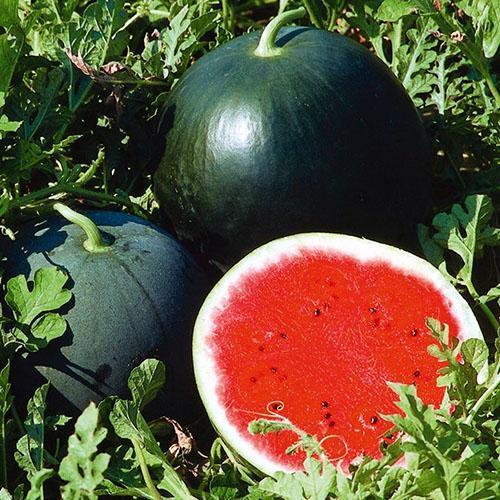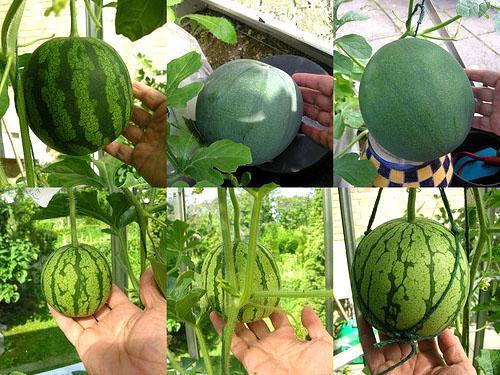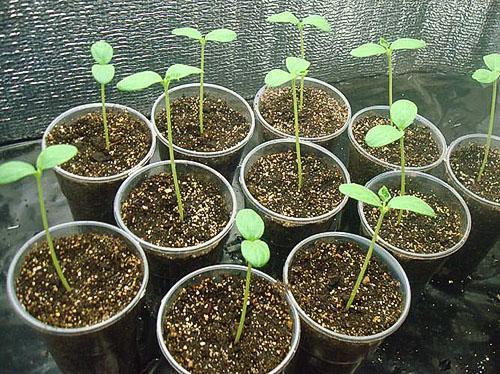Growing watermelons at their summer cottage in Siberia
 Knowing the agrotechnics of a thermophilic culture, you can grow a watermelon in any region of the country. But that doesn't mean it will be easy. If you do not create the desired temperature regime, illumination, then watering and fertilizers you cannot replace them. The cultivation of watermelons in Siberia is possible only under special conditions - in greenhouses, on warm beds, through seedlings.
Knowing the agrotechnics of a thermophilic culture, you can grow a watermelon in any region of the country. But that doesn't mean it will be easy. If you do not create the desired temperature regime, illumination, then watering and fertilizers you cannot replace them. The cultivation of watermelons in Siberia is possible only under special conditions - in greenhouses, on warm beds, through seedlings.
Conditions for obtaining sweet watermelon

- Seeds germinate at a temperature not lower than 14 0.
- For the roots, a temperature of 24-30 is favorable 0.
- The average daily temperature during flowering and ovary formation should be at least 18 0.
- The night temperature of the ambient air in summer is needed above 15 0.
In this case, the length of the day plays an important role and the receipt of solar energy 10,000 lux daily.
It is possible to create such conditions in Siberia if the culture is grown in a seedling method in a protected ground, on high, warm ridges... Filled with plant residues and mullein, they create the right temperature for the roots.
The root of the watermelon is branched, taproot. The stem goes deep, and the roots, located in the upper fertile layer, mainly deliver food. In drought, the taproot draws water from the depths. Therefore, on a warm bed, watermelons do not collect nitrates from manure, which turns into humus at the time of filling.
Thus, you can get a watermelon in Siberia that is not inferior in taste to the southern one, if you apply some techniques:
- seedling method;
- cultivation in greenhouses;
- use of a warm high bed;
- the use of early ripening zoned varieties.
The main factor, the number of sunny days from Siberia meets the requirements. There is irreplaceable solar energy, other requirements are fulfilled in each locality in its own way. Siberia is large and Omsk and Ulan-Ude cannot be compared in terms of climate. However, watermelons are grown everywhere.
Growing seedlings
 Siberian summer is short. In the third decade of June, frosts are still possible, and in mid-August they are already waiting for the first frost. Therefore, the seedlings will help both to grow a watermelon in a greenhouse and in the open field. Therefore, for the first month, the watermelon grows on the windowsill. It is important at this time to create good conditions. illuminationespecially when the fifth leaf begins to appear. In this case, you need bright lighting, preferably with special lamps like "Almaz" for 10 hours a day. Seedlings at the age of one month are planted in a warm ground.
Siberian summer is short. In the third decade of June, frosts are still possible, and in mid-August they are already waiting for the first frost. Therefore, the seedlings will help both to grow a watermelon in a greenhouse and in the open field. Therefore, for the first month, the watermelon grows on the windowsill. It is important at this time to create good conditions. illuminationespecially when the fifth leaf begins to appear. In this case, you need bright lighting, preferably with special lamps like "Almaz" for 10 hours a day. Seedlings at the age of one month are planted in a warm ground.
How to grow a watermelon in a greenhouse?
The construction of greenhouses began near Moscow precisely in order to put watermelons on the Tsar's table. But the result was not very good. There was no necessary lighting, and this is one of the main conditions for obtaining sweet fruits.
 A greenhouse for watermelons should have good transparency and ventilation. Modern materials make it possible to fulfill this condition. Tomato greenhouses are suitable for growing watermelons. You can make them good neighbors. Watermelons are led with a vertical lash or flooring. You can put some of the lashes on the flooring, hang the other.
A greenhouse for watermelons should have good transparency and ventilation. Modern materials make it possible to fulfill this condition. Tomato greenhouses are suitable for growing watermelons. You can make them good neighbors. Watermelons are led with a vertical lash or flooring. You can put some of the lashes on the flooring, hang the other.
Plants are planted in a row with a distance of 70 cm between the holes. It is necessary to create good illumination for each leaf. Therefore, the plants are not placed more often. Seedlings are planted in late May, early June, when the ground is well warmed up. The hole is made large, the plant is slightly deepened, but there should be clean sand around in order to preserve the delicate roots at first.Fragile plants are shaded for 2-3 days until they take root.
 Caring for watermelons in a greenhouse consists of timely watering using low-concentration fertilizer mixtures in early summer. To prevent the appearance of rot and insects effectively spraying EM-1 Baikal throughout the season.
Caring for watermelons in a greenhouse consists of timely watering using low-concentration fertilizer mixtures in early summer. To prevent the appearance of rot and insects effectively spraying EM-1 Baikal throughout the season.
Watermelons will bloom at the end of June, first male flowers, then female flowers will appear, which can be distinguished by the presence of a mini-fruit instead of a leg. Pollination is carried out in the morning. The male flower is cut off, the petals are removed and its stamens are leaned against the pistil of the female plant.
 This procedure is repeated several times for guarantee. As soon as the ovary begins to grow, pollination has occurred. After that, the lash growing higher is cut off, leaving several sheets for pouring. The side stepsons are removed. For a greenhouse plant, it is enough to leave three fruits and remove the growing green mass in the future.
This procedure is repeated several times for guarantee. As soon as the ovary begins to grow, pollination has occurred. After that, the lash growing higher is cut off, leaving several sheets for pouring. The side stepsons are removed. For a greenhouse plant, it is enough to leave three fruits and remove the growing green mass in the future.
 The growing fruits with their weight will pull the whip from the suspension. Therefore, they need to be hung in advance in a "string bag" with fastening to the trellis, regardless of the lash. When pouring, watermelons are demanding on soil moisture. But as soon as the filling is over, there is no need to water them. The taproot will get enough water, while the watermelon will be sweet and sugary.
The growing fruits with their weight will pull the whip from the suspension. Therefore, they need to be hung in advance in a "string bag" with fastening to the trellis, regardless of the lash. When pouring, watermelons are demanding on soil moisture. But as soon as the filling is over, there is no need to water them. The taproot will get enough water, while the watermelon will be sweet and sugary.
Harvest watermelons when they are ripe. A sign of the readiness of the fetus will be the dried up nearest antennae, a slight crunch when squeezing the fetus and the time elapsed from tying. It should be from 35 days to 45. The risk of removing an incompletely ripe fruit always remains.
Growing watermelons without a greenhouse
 Bearing in mind that the Siberian summer is unpredictable, that a cold snap is possible at any time, even in the open ground, protection is provided for watermelons. Usually, high ridges are prepared for them, inside which biofuel is laid. The ridge is covered with a black film as mulch or geotextile. Arrange watermelons on a hill, closer to the sun and so that the water does not stagnate during watering.
Bearing in mind that the Siberian summer is unpredictable, that a cold snap is possible at any time, even in the open ground, protection is provided for watermelons. Usually, high ridges are prepared for them, inside which biofuel is laid. The ridge is covered with a black film as mulch or geotextile. Arrange watermelons on a hill, closer to the sun and so that the water does not stagnate during watering.
 The holes are prepared in advance, an incision is made for the plants in the shelter, a protective cap is installed above it in order to throw a covering material over it if it gets colder. A closed bed keeps weeds out and keeps you warm even on cold nights.
The holes are prepared in advance, an incision is made for the plants in the shelter, a protective cap is installed above it in order to throw a covering material over it if it gets colder. A closed bed keeps weeds out and keeps you warm even on cold nights.
 In the open air, pollination occurs naturally. The gardener needs to monitor the formation of plants, preventing overgrowth with lashes of 3.4 orders of magnitude. In the open field, the watermelon itself regulates the load, the extra fruits fall off, reaching the size of a walnut.
In the open air, pollination occurs naturally. The gardener needs to monitor the formation of plants, preventing overgrowth with lashes of 3.4 orders of magnitude. In the open field, the watermelon itself regulates the load, the extra fruits fall off, reaching the size of a walnut.
How to collect watermelon seeds?
 You can buy seeds, but not always there is exactly the variety that you like. Often the name of the variety on the bag and its contents do not match. Therefore, the question of how to properly collect the seeds of watermelon and other crops has become relevant. For all melons and gourds, the core of the fruit with seeds is selected, they are left for 3-4 days for fermentation, covering the container on top with a cloth. Later, the seeds are washed of mucus, dried, placed in a box, and the variety and harvest year are signed.
You can buy seeds, but not always there is exactly the variety that you like. Often the name of the variety on the bag and its contents do not match. Therefore, the question of how to properly collect the seeds of watermelon and other crops has become relevant. For all melons and gourds, the core of the fruit with seeds is selected, they are left for 3-4 days for fermentation, covering the container on top with a cloth. Later, the seeds are washed of mucus, dried, placed in a box, and the variety and harvest year are signed.
You can use seeds for sowing after two years. Fresh seeds produce many male flowers and very few ovaries. The shelf life of seeds is 5-6 years under normal storage conditions.